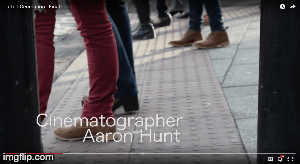Our target audience are intellectuals and like to watch documentaries so they would be use to having to listen along with visuals and in our case this is very poignant. Our visuals go along in an almost montage like state with the narration giving an intense blast to the senses of your eyes whilst you also listen to the narration going along with it. The visuals mise en scene go along with it very well: When in the narration it says the "latest glamour model" you see a model walking down a catwalk. the mise en scene linking to what is said in the narration. This carries on throughout the opening.
I think this constant change of scene will address our target audience because it is always changing, within the opening at least, and so it is working there intellectual minds. Making them think over and over, processing all these different images and settings.

A few of the beginning shots from the opening sequence, showing the change in visuals that the watcher gets in the first c.15seconds.
Audience Viewing
We did a viewing of our opeing sequence to a small audience
within our age range and recorded the answers to questions we asked them after
they watched it, which is what is quoted below.
1. So before we entered the tattoo parlour, what did you
think the documentary was about?
Matt - "Life and clothes."
Asel - "Culture and individuality."
2. And then when we entered the tattoo parlour and you
started seeing all the mise-on-scene, did you make the connection, that it was
about culture and expression through tattoos?
George - "Yeah, I saw it as a another way to express
yourself, and individuality through tattoos."
Asel - "I definitely thought it was about culture and
expression, with the tattoo artist and the parlour, but it took a while to get
there, but that created good enigma."
Toby - "Yeah, I thought it was quite good in that way,
because it made me think 'What's going to come next?'"
Asel - "Yes, because you gave a little background to
the individualism and didn't give too much away which kept me wanting to
watch."
Toby -
"Definitely because it felt like a documentary when watching, and included
lots of documentary-esque shots, but also kept me hooked and didn't give too
much away, just like an enigmatic movie opening."
George - "I would definitely be interested in watching
it, I feel that the movie appeals to people of our age, 16-17, and therefore
reaches your target audience effectively."
Martyn - "I feel your marketing campaign would be very
effective for people of our age, and like Matt said, this shows your film
opening is effective at hitting your target audience. I would be interested in
watching the film."
Audience we interviewed ---
Audience we interviewed ---
Narrative theory
We used Barthes enigma codes to make our opening scene enigmatic, so it was not just like all documentaries telling you straight away what it was about but more like a film actually creating enigma, this caused the audience to ask question and try and make links with what they are seeing and hearing.
We used Levi Strauss in a sense of old opinion on tattoos vs the new opinion of tattoos. So not the classic way of Strauss (Good vs Evil etc) but still two things which are apparent and explored in the documentary.
We did not use Todorov because even though we had aspects like a film in the documentary it was not a film in every sense of the word so it did not have Equilibrium, Disruption of equilibrium, Restoration of Equilibrium, New Equilibrium. It just sifted through the idea, the question presented at the beginning of the doc.
We used Propp but not in the classic Hero, villain, dispatcher etc type of characters. Instead we would have the normal characters of a documentary the interviewer and the person being interviewed.
